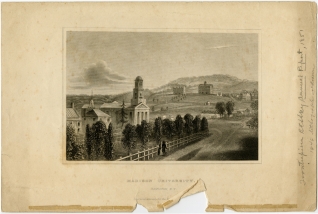As their first step in rebuilding the University, the two sets of Trustees in August, 1850, jointly appointed new faculty members to work with Professors Eaton and Spear to ensure that instruction would be provided in the autumn without interruption and made announcements to that effect in the press. It was with much anxiety, however, that the friends of Hamilton awaited the new academic year. When faculty and students assembled on the 24th of October at the ringing of the chapel bell, both were conscious that this was no ordinary beginning of a fall term. To their great satisfaction, however, they discovered that thirty-three young men were present and that this group included representatives of all classes of the collegiate, theological, and academic departments. Immensely cheered, they listened to appropriate remarks by Professor Eaton and joined in a heartfelt prayer of thanksgiving. The auspices for recovery were more favorable than anyone had dared hope.
Though now assured of a student body and a faculty with which to resume operations, Madison University sorely needed a vigorous and wise executive, not only to direct affairs on the campus but also to restore the confidence of former patrons. There had been no such leader since illness and death removed Nathaniel Kendrick’s steadying hand. In Stephen W. Taylor, who was then, in effect President of the University at Lewisburg (Bucknell), the Trustees found a man measuring up to the requirements of the office.
Taylor’s career in shaping the nascent Pennsylvania institution had not belied his reputation for practical common sense and indomitable energy, gained as a member of the faculty at Hamilton from 1834 to 1845. On being invited in August 1850, to return as Professor of Mathematics and Natural History, he declined, but gave some hope that he would consider a call to the Presidency. Knowing that no formal provision existed for the office, he insisted that its duties and salary be specified and that he have unanimous Trustee and faculty approval. He had no intention of stepping into a situation where divisive elements were at work nor was he a man to tolerate them should they germinate. He understood rather completely the painful history of the last few years and recognized that united support for its leader was essential to the University’s recovery.
Agreeable to Dr. Taylor’s stipulations, the Trustees on February 6, 1851, created the office of President of Madison University and asked him to take it and the chair of mathematics and natural philosophy at





